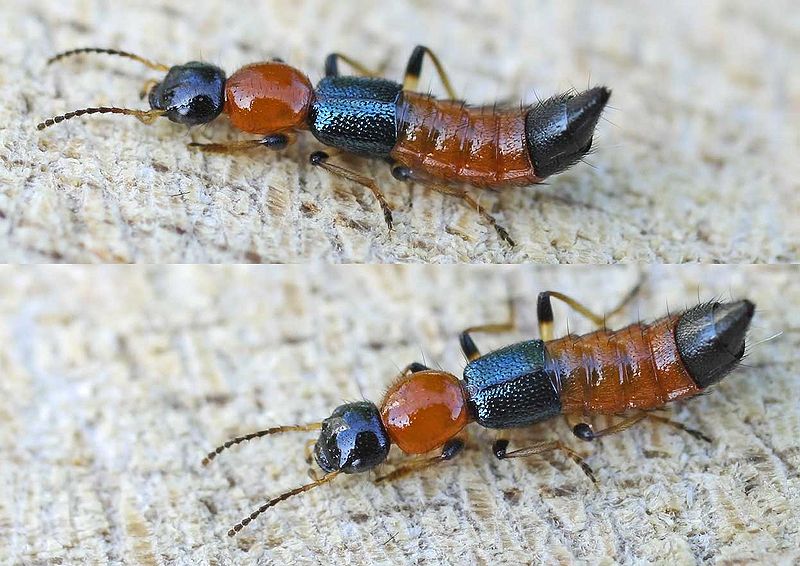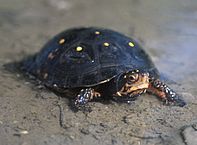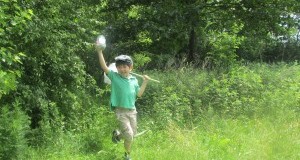Prehistoric cave paintings show that the pitfall trap, a simple covered or uncovered hole designed to capture animals, came into being very early in our evolution as a species. Indeed, they are still used by hunters and field researchers today. Pitfall traps also provide pet keepers with a simple, effective means of collecting live food for reptiles, amphibians, tarantulas, scorpions, mantids and other terrarium animals.
Building and Baiting the Trap
 To create a pitfall trap, simple bury a can or jar flush with the ground and cover it with a board that is slightly elevated by small stones. This will keep rain out while allowing invertebrates to enter.
To create a pitfall trap, simple bury a can or jar flush with the ground and cover it with a board that is slightly elevated by small stones. This will keep rain out while allowing invertebrates to enter.
An amazing assortment of creatures will simply stumble into such a trap, but you can increase its effectiveness by adding bait. A bit of ripe fruit, molasses, honey and some tropical fish flakes will lure all sorts of insects, sow bugs and other invertebrates (snails and slugs are especially fond of beer). Be sure to keep some dead leaves or paper towels in the trap as well, to provide places for your catch to hide and keep away from one another.
Boards or other cover spread about an area, which can be easily turned and checked, will also attract a variety of insects. Spraying the area with a hose during dry weather will attract increased numbers of invertebrates to these shelters.
Cautions
Always use caution when examining your catch, as potentially dangerous spiders, scorpions, hornets and other such creatures may be present. Have a good field guide on hand if you are unfamiliar with local species, and use feeding tongs to remove animals from the trap.
Native Beetles in the Terrarium
If your interests extend to native invertebrates, your trap will likely provide you with some pleasant surprises.
One of my favorite and rather frequent catches is the caterpillar hunter (Calosoma scrutator), a widespread beetle that feeds upon caterpillars and other soft-bodied insects (a relative, the forest caterpillar hunter, was imported to the USA from Europe in 1905 to battle gypsy moths). Next time I’ll write a bit more about the natural history and captive care of these colorful, interesting, but largely over-looked beetles.
Further Reading
I have long relied heavily upon wild-caught invertebrates as food for animals in both zoo and my own collections. In the past I have written about collecting leaf litter and arboreal insects, as well as devices such as termite traps and the Zoo Med Bug Napper. Please see the following articles for more information:
Collecting Leaf Litter Invertebrates
Collecting Live Food: an Entomologist’s Technique
Collecting Live Insects for Birds
Image referenced from Wikipedia and orignally posted by
 That Reptile Blog – Reptile, Amphibian and Exotic Pet Care and Information
That Reptile Blog – Reptile, Amphibian and Exotic Pet Care and Information



I really enjoyed both parts of this article which brings me to my encounters with carabus nemoralis up in pelham bay park. in rotten tree stump about a dozen of them I collected about 4 fed them worms and slugs but i think i let the tank get to damp and disaster struck beautiful beetles now that I have more positive results with my present 2 tanks with an assortment of sow bugs millipedes 2 centepedes a the carolina crickets which i mentioned which are still ticking about 4 types of small medium ground beetle including an elusive soil dwelling pretty large ground beetle larva probably from a previous couple of 19mm length black sidewalk ground beetles and a possible culture of field crickets from previous tank raised generation. one of the tanks is growing some pretty kool vegetation in time for spring .will keep you posted on future collecting for my tanks and maintenance..thank you for your insights and feedback .
Hello Noel,
Thanks for the info, I’m very glad to hear of someone other than myself who does such things! Sounds like a nice collection, very interesting, and lots to learn. Back in the mid 80’s, when I was drafted to set up the first invertebrate collection housed in the BX Zoo in decades (Jungleworld), it was lessons learned in just the types of terrariums you describe that helped me the most.
There is a Great Horned Owl nest in Pelham Bay most every year, the pair will be on eggs by now…I don’t know the current location, but you may want to check around. I’ve seen 3 great horned owls at once roosting in pines near the Orchard beach nature center as well – rangers sometimes show folks who express a sincere interest.
Good luck and please keep me posted.
Best regards, Frank Indiviglio.
Hi frank
I read this article last evening then went to try it myself. i setout 5 traps in drifrent spots from the garden to the middle of the tall grass in the field. this mornin i had tons of incests (too many big dady longlegs for comfert) small black long ant flys with stingers (bullfrogs seem to like these) alot of bettles which i realised and small crickets/grass hoppers allso some centapeeds etc… point is i was supprised at the sucess!
Great to hear, Cody..thanks for writing in! It’s a great technique, have used for field surveys of herps, rodents as well…some drawbacks, but I enjoy. I generally find something I haven’t seen before, often wind up with side projects; while field sweeping last week, came up with several spiders that I’m saving for a friend to ID, all new to me despite looking at similar habitats since childhood,
Enjoy, let me know how all goes, Frank
Hi!
I’ve always been tempted to catch my own bugs to feed my Leopard Gecko, but I’ve been ha wily cautioned when it comes to wild caught bugs because they could be carrying chemicals and sprays around with them from other lawns or trees that could be harmful to my little reptile. Do you have any advice or wisdom on this problem?
Hi Holly,
Some caution is needed, re pesticides and species ID, but I’ve used in zoo and home with great success.
Following articles have more on these concerns, and an explanation of other collecting techniques.
Please let me know if you need more info, Frank
http://blogs.thatpetplace.com/thatreptileblog/2009/08/17/wild-caught-invertebrates-as-reptile-and-amphibian-food-pesticide-concerns-part-1/#.VMgHYC5kCGE
http://blogs.thatpetplace.com/thatreptileblog/2009/10/02/wild-caught-invertebrates-as-reptile-and-amphibian-food-pesticide-concerns-part-2/#.VMgHWi5kCGE
http://blogs.thatpetplace.com/thatreptileblog/2014/02/18/collecting-insects-reptile-amphibian-food-traps-tips/#.VMgHpC5kCGE
Neat article!!! I’m mostly commenting because callisoma scrutator is also one of my favorites! I caught one in my bathroom a couple years ago, and thought it was so beautiful I wanted to keep it, but I knew my husband was getting tired of my “bug fetish”, so I took some photos and released it. When I texted the photos to my husband, he offered to get me a terrarium. So I ran back outside and re-caught it. I had it for over a year, it’s been one of my favorite insect pets.
I used to be terrified of anything with more than 4 legs. Now I study them all the time (I consider myself an amateur entomologist). And I even keep some as free roaming pets in and around my home, like certain spider species (non-poisonous to people, and live in a dedicated web), and mangled rescued Lepidoptera. Even certain wasp species are welcome here (most of them are not as aggressive or dangerous as they seem.). In return, I get a source of entertainment, and pest control. Plus some awesome stories. And I’m never bored, lol. Bugs are everywhere!! So if there’s nothing else to do, all I have to do is look around for another 6 legged show to watch (or 8 legged, or 30 legged, or however many legs a millipede has, because they won’t hold still enough for me to count, lol)